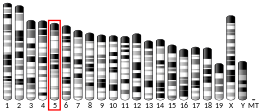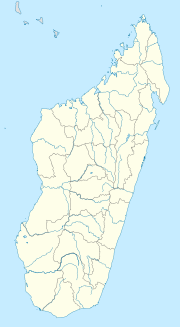암피레귤린
AmphiregulinAREG라고도 알려진 암피레귤린은 252개의 아미노산과 함께 막 통과 당단백질로 합성되는 단백질로 AREG [5][6][7]유전자에 의해 암호화된다.인간에게서.[8]
기능.
이 유전자에 의해 암호화된 단백질은 표피성장인자([5]EGF) 계열의 구성원이다.
이것은 중요한 자가분비 성장인자이며 성세포, 슈반 세포 및 섬유아세포의 승모겐이다.표피성장인자(EGF)의 배위자이며, TGF-alpha(TGF-alpha)의 형질전환과 관련이 있다.이 단백질은 표피 성장인자 수용체(EGFR)와 상호작용하여 정상적인 상피 세포의 성장을 촉진합니다.
생물학적 역할
AREG는 [9][10][11][12][13]유선의 에스트로겐 작용과 관 발달에 중요한 요소이다.암피레귤린은 암피레귤린 녹아웃 [12]생쥐의 관성 성장 부재로 입증되었듯이 유방관 발달에 필수적인 것으로 밝혀졌다.이는 EGFR 및 ERα 녹아웃 생쥐의 표현형과 유사하며, 덕트 성장 부재를 보인다.[12]암피레귤린은 난소, 태반, 췌장, 가슴, 폐, 비장 등 신체의 많은 부분에서 발현된다.암피레귤린의 발현은 TGF-α, TNF-α,[14][15] 인터류킨1, 프로스타글란딘에 의해 유도될 수 있다.
임상적 의의
건선
이 부호화 단백질의 돌연변이는 건선 유사 피부 [16][5]표현형과 관련되어 있다.암피레귤린의 높은 순환 수준은 AGVHD [17]진행과 관련이 있다.[18][19]
암
암피레귤린의 과잉발현은 유방, 전립선, 대장, 췌장, 폐, 비장, [20][21][22]방광의 암과 관련이 있다.
류마티스 관절염
AREG의 발현은 섬유아세포의 증식과 염증성 사이토카인 인터류킨8 및 혈관내피성장인자(VEGF)[23]의 생성과 관련이 있는 것으로 보인다.
염증
암피레귤린은 세포반응 타입 [24]2의 일부이다.암피레귤린의 세포원은 인터류킨 33에 의존하는 선천성 림프세포 2(ILC2)인 것으로 밝혀졌다.ILC2는 장의 조직 손상 및 IL-33에 의한 활성화 후 암피레귤린을 발현하였다.또한, IL-33이 포함된 내인성 AREG는 T림프구가 정상인 생쥐와 결핍된 [25]생쥐에서 장내 염증을 감소시켰다.
레퍼런스
- ^ a b c GRCh38: 앙상블 릴리즈 89: ENSG00000109321 - 앙상블, 2017년 5월
- ^ a b c GRCm38: 앙상블 릴리즈 89: ENSMUSG000029378 - 앙상블, 2017년 5월
- ^ "Human PubMed Reference:". National Center for Biotechnology Information, U.S. National Library of Medicine.
- ^ "Mouse PubMed Reference:". National Center for Biotechnology Information, U.S. National Library of Medicine.
- ^ a b c "Entrez Gene: AREG amphiregulin (schwannoma-derived growth factor)".
- ^ Shoyab M, Plowman GD, McDonald VL, Bradley JG, Todaro GJ (February 1989). "Structure and function of human amphiregulin: a member of the epidermal growth factor family". Science. 243 (4894 Pt 1): 1074–6. Bibcode:1989Sci...243.1074S. doi:10.1126/science.2466334. PMID 2466334.
- ^ Plowman GD, Green JM, McDonald VL, Neubauer MG, Disteche CM, Todaro GJ, Shoyab M (May 1990). "The amphiregulin gene encodes a novel epidermal growth factor-related protein with tumor-inhibitory activity". Molecular and Cellular Biology. 10 (5): 1969–81. doi:10.1128/MCB.10.5.1969. PMC 360543. PMID 2325643.
- ^ "AREG (amphiregulin (schwannoma-derived growth factor))". atlasgeneticsoncology.org. Retrieved 2019-08-27.
- ^ Aupperlee MD, Leipprandt JR, Bennett JM, Schwartz RC, Haslam SZ (May 2013). "Amphiregulin mediates progesterone-induced mammary ductal development during puberty". Breast Cancer Research. 15 (3): R44. doi:10.1186/bcr3431. PMC 3738150. PMID 23705924.
- ^ LaMarca HL, Rosen JM (2007). "Estrogen regulation of mammary gland development and breast cancer: amphiregulin takes center stage". Breast Cancer Research. 9 (4): 304. doi:10.1186/bcr1740. PMC 2206713. PMID 17659070.
- ^ Kariagina A, Xie J, Leipprandt JR, Haslam SZ (October 2010). "Amphiregulin mediates estrogen, progesterone, and EGFR signaling in the normal rat mammary gland and in hormone-dependent rat mammary cancers". Hormones & Cancer. 1 (5): 229–44. doi:10.1007/s12672-010-0048-0. PMC 3000471. PMID 21258428.
- ^ a b c McBryan J, Howlin J, Napoletano S, Martin F (June 2008). "Amphiregulin: role in mammary gland development and breast cancer". Journal of Mammary Gland Biology and Neoplasia. 13 (2): 159–69. doi:10.1007/s10911-008-9075-7. PMID 18398673. S2CID 13229645.
- ^ Sternlicht MD, Sunnarborg SW (June 2008). "The ADAM17-amphiregulin-EGFR axis in mammary development and cancer". Journal of Mammary Gland Biology and Neoplasia. 13 (2): 181–94. doi:10.1007/s10911-008-9084-6. PMC 2723838. PMID 18470483.
- ^ "AREG (amphiregulin (schwannoma-derived growth factor))". atlasgeneticsoncology.org. Retrieved 2019-08-27.
- ^ Busser B, Sancey L, Brambilla E, Coll JL, Hurbin A (December 2011). "The multiple roles of amphiregulin in human cancer". Biochimica et Biophysica Acta (BBA) - Reviews on Cancer. 1816 (2): 119–31. doi:10.1016/j.bbcan.2011.05.003. PMID 21658434.
- ^ Bhagavathula N, Nerusu KC, Fisher GJ, Liu G, Thakur AB, Gemmell L, et al. (April 2005). "Amphiregulin and epidermal hyperplasia: amphiregulin is required to maintain the psoriatic phenotype of human skin grafts on severe combined immunodeficient mice". The American Journal of Pathology. 166 (4): 1009–16. doi:10.1016/S0002-9440(10)62322-X. PMC 1780140. PMID 15793282.
- ^ Bhagavathula N, Nerusu KC, Fisher GJ, Liu G, Thakur AB, Gemmell L, et al. (April 2005). "Amphiregulin and epidermal hyperplasia: amphiregulin is required to maintain the psoriatic phenotype of human skin grafts on severe combined immunodeficient mice". The American Journal of Pathology. 166 (4): 1009–16. doi:10.1016/S0002-9440(10)62322-X. PMC 1780140. PMID 15793282.
- ^ Holtan SG, DeFor TE, Panoskaltsis-Mortari A, Khera N, Levine JE, Flowers ME, et al. (August 2018). "Amphiregulin modifies the Minnesota Acute Graft-versus-Host Disease Risk Score: results from BMT CTN 0302/0802". Blood Advances. 2 (15): 1882–1888. doi:10.1182/bloodadvances.2018017343. PMC 6093743. PMID 30087106.
- ^ Piepkorn M (April 1996). "Overexpression of amphiregulin, a major autocrine growth factor for cultured human keratinocytes, in hyperproliferative skin diseases". The American Journal of Dermatopathology. 18 (2): 165–71. doi:10.1097/00000372-199604000-00010. PMID 8739992.
- ^ Busser B, Sancey L, Brambilla E, Coll JL, Hurbin A (December 2011). "The multiple roles of amphiregulin in human cancer". Biochimica et Biophysica Acta (BBA) - Reviews on Cancer. 1816 (2): 119–31. doi:10.1016/j.bbcan.2011.05.003. PMID 21658434.
- ^ "AREG (amphiregulin (schwannoma-derived growth factor))". atlasgeneticsoncology.org. Retrieved 2019-08-27.
- ^ McBryan J, Howlin J, Napoletano S, Martin F (June 2008). "Amphiregulin: role in mammary gland development and breast cancer". Journal of Mammary Gland Biology and Neoplasia. 13 (2): 159–69. doi:10.1007/s10911-008-9075-7. PMID 18398673. S2CID 13229645.
- ^ Yamane S, Ishida S, Hanamoto Y, Kumagai K, Masuda R, Tanaka K, et al. (April 2008). "Proinflammatory role of amphiregulin, an epidermal growth factor family member whose expression is augmented in rheumatoid arthritis patients". Journal of Inflammation. 5: 5. doi:10.1186/1476-9255-5-5. PMC 2396620. PMID 18439312.
- ^ Zaiss DM, Yang L, Shah PR, Kobie JJ, Urban JF, Mosmann TR (December 2006). "Amphiregulin, a TH2 cytokine enhancing resistance to nematodes". Science. 314 (5806): 1746. Bibcode:2006Sci...314.1746Z. doi:10.1126/science.1133715. PMID 17170297. S2CID 27808704.
- ^ Monticelli LA, Osborne LC, Noti M, Tran SV, Zaiss DM, Artis D (August 2015). "IL-33 promotes an innate immune pathway of intestinal tissue protection dependent on amphiregulin-EGFR interactions". Proceedings of the National Academy of Sciences of the United States of America. 112 (34): 10762–7. Bibcode:2015PNAS..11210762M. doi:10.1073/pnas.1509070112. PMC 4553775. PMID 26243875.
추가 정보
- Culouscou JM, Remacle-Bonnet M, Carlton GW, Plowman GD, Shoyab M (1993). "Colorectum cell-derived growth factor (CRDGF) is homologous to amphiregulin, a member of the epidermal growth factor family". Growth Factors. 7 (3): 195–205. doi:10.3109/08977199209046924. PMID 1333777.
- Cook PW, Mattox PA, Keeble WW, Pittelkow MR, Plowman GD, Shoyab M, et al. (May 1991). "A heparin sulfate-regulated human keratinocyte autocrine factor is similar or identical to amphiregulin". Molecular and Cellular Biology. 11 (5): 2547–57. doi:10.1128/MCB.11.5.2547. PMC 360024. PMID 2017164.
- Kimura H, Fischer WH, Schubert D (November 1990). "Structure, expression and function of a schwannoma-derived growth factor". Nature. 348 (6298): 257–60. Bibcode:1990Natur.348..257K. doi:10.1038/348257a0. PMID 2234093. S2CID 4275004.
- Plowman GD, Green JM, McDonald VL, Neubauer MG, Disteche CM, Todaro GJ, Shoyab M (May 1990). "The amphiregulin gene encodes a novel epidermal growth factor-related protein with tumor-inhibitory activity". Molecular and Cellular Biology. 10 (5): 1969–81. doi:10.1128/MCB.10.5.1969. PMC 360543. PMID 2325643.
- Shoyab M, Plowman GD, McDonald VL, Bradley JG, Todaro GJ (February 1989). "Structure and function of human amphiregulin: a member of the epidermal growth factor family". Science. 243 (4894 Pt 1): 1074–6. Bibcode:1989Sci...243.1074S. doi:10.1126/science.2466334. PMID 2466334.
- Shoyab M, McDonald VL, Bradley JG, Todaro GJ (September 1988). "Amphiregulin: a bifunctional growth-modulating glycoprotein produced by the phorbol 12-myristate 13-acetate-treated human breast adenocarcinoma cell line MCF-7". Proceedings of the National Academy of Sciences of the United States of America. 85 (17): 6528–32. Bibcode:1988PNAS...85.6528S. doi:10.1073/pnas.85.17.6528. PMC 282006. PMID 3413110.
- Chen CS, Bejcek BE, Kersey JH (1995). "A mapping study of 13 genes on human chromosome bands 4q11-->q25". Cytogenetics and Cell Genetics. 69 (3–4): 260–5. doi:10.1159/000133976. PMID 7698025.
- Cook PW, Piepkorn M, Clegg CH, Plowman GD, DeMay JM, Brown JR, Pittelkow MR (November 1997). "Transgenic expression of the human amphiregulin gene induces a psoriasis-like phenotype". The Journal of Clinical Investigation. 100 (9): 2286–94. doi:10.1172/JCI119766. PMC 508424. PMID 9410906.
- Wong L, Deb TB, Thompson SA, Wells A, Johnson GR (March 1999). "A differential requirement for the COOH-terminal region of the epidermal growth factor (EGF) receptor in amphiregulin and EGF mitogenic signaling". The Journal of Biological Chemistry. 274 (13): 8900–9. doi:10.1074/jbc.274.13.8900. PMID 10085134.
- Reddy KB, Krueger JS, Kondapaka SB, Diglio CA (July 1999). "Mitogen-activated protein kinase (MAPK) regulates the expression of progelatinase B (MMP-9) in breast epithelial cells". International Journal of Cancer. 82 (2): 268–73. doi:10.1002/(SICI)1097-0215(19990719)82:2<268::AID-IJC18>3.0.CO;2-4. PMID 10389762.
- Fernandes AM, Hamburger AW, Gerwin BI (July 1999). "Production of epidermal growth factor related ligands in tumorigenic and benign human lung epithelial cells". Cancer Letters. 142 (1): 55–63. doi:10.1016/S0304-3835(99)00166-4. PMID 10424781.
- Lee SB, Huang K, Palmer R, Truong VB, Herzlinger D, Kolquist KA, et al. (September 1999). "The Wilms tumor suppressor WT1 encodes a transcriptional activator of amphiregulin". Cell. 98 (5): 663–73. doi:10.1016/S0092-8674(00)80053-7. PMID 10490105. S2CID 14607182.
- Tokumaru S, Higashiyama S, Endo T, Nakagawa T, Miyagawa JI, Yamamori K, et al. (October 2000). "Ectodomain shedding of epidermal growth factor receptor ligands is required for keratinocyte migration in cutaneous wound healing". The Journal of Cell Biology. 151 (2): 209–20. doi:10.1083/jcb.151.2.209. PMC 2192647. PMID 11038170.
- Ebert MP, Hernberg S, Fei G, Sokolowski A, Schulz HU, Lippert H, Malfertheiner P (July 2001). "Induction and expression of cyclin D3 in human pancreatic cancer". Journal of Cancer Research and Clinical Oncology. 127 (7): 449–54. doi:10.1007/s004320100235. PMID 11469683. S2CID 33146049.
- Berquin IM, Dziubinski ML, Nolan GP, Ethier SP (July 2001). "A functional screen for genes inducing epidermal growth factor autonomy of human mammary epithelial cells confirms the role of amphiregulin". Oncogene. 20 (30): 4019–28. doi:10.1038/sj.onc.1204537. PMID 11494130.
- Thøgersen VB, Sørensen BS, Poulsen SS, Orntoft TF, Wolf H, Nexo E (August 2001). "A subclass of HER1 ligands are prognostic markers for survival in bladder cancer patients". Cancer Research. 61 (16): 6227–33. PMID 11507076.
- Wolfgang CD, Essand M, Lee B, Pastan I (November 2001). "T-cell receptor gamma chain alternate reading frame protein (TARP) expression in prostate cancer cells leads to an increased growth rate and induction of caveolins and amphiregulin". Cancer Research. 61 (22): 8122–6. PMID 11719440.
- Schiemann U, Konturek J, Assert R, Rembiasz K, Domschke W, Konturek S, Pfeiffer A (February 2002). "mRNA expression of EGF receptor ligands in atrophic gastritis before and after Helicobacter pylori eradication". Medical Science Monitor. 8 (2): CR53-8. PMID 11859273.
- Tørring N, Møller-Ernst Jensen K, Lund L, Nielsen JE, Djurhuus JC, Poulsen SS, Nexø E (April 2002). "Possible autocrine loop of the epidermal growth factor system in patients with benign prostatic hyperplasia treated with finasteride: a placebo-controlled randomized study". BJU International. 89 (6): 583–90. doi:10.1046/j.1464-410X.2002.02665.x. PMID 11942969. S2CID 42241168.
- Hurbin A, Dubrez L, Coll JL, Favrot MC (December 2002). "Inhibition of apoptosis by amphiregulin via an insulin-like growth factor-1 receptor-dependent pathway in non-small cell lung cancer cell lines". The Journal of Biological Chemistry. 277 (51): 49127–33. doi:10.1074/jbc.M207584200. PMID 12356750.
외부 링크
- UCSC Genome Browser의 인간 AR 게놈 위치 및 AR 유전자 세부 정보 페이지.
- UCSC Genome Browser의 인간 AREG 게놈 위치 및 AREG 유전자 상세 페이지.
- PDB for UniProt: P15514 (Amphiregulin) (PDBe-KB)에서 구할 수 있는 모든 구조 정보의 개요.






